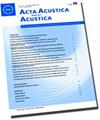Measurement of "Reed to Room"-Transfer Functions
Q1 Arts and Humanities
引用次数: 1
Abstract
A method is proposed here to synthesize the acoustic response of a room to a musical reed wind instrument with tone holes played by a musician. The procedure uses convolution of a) two measured pulse responses and b) the mouthpiece pressure during playing. The novelty of the approach is to include the sound radiation directivity of the source in the impulse response measurement of the room by using the wind instrument's air column as an exciter. At the reed input end of the air column pressure pulses at typical peak pressures of several kilopascals are generated using a compressor and a solenoid valve, which provides a high SNR even at distant measurement positions. For auralization purpose, the source signal measurement is done very close to the sound generation locus, i.e. inside the mouthpiece. Because this measurement is largely insensitive to room acoustics, the proposed method can be considered a very convenient alternative to music recordings in anechoic conditions. As a proof of concept we report here experimental results for the case of a bassoon. The method can be extended to auralizations of reed and lip-reed musical instruments in virtual acoustic scenes, and sheds light on the importance of the reflective and radiative properties of the air column for the sound coloration.“芦苇到房间”的测量-传递函数
本文提出了一种合成房间对音乐家演奏的带有音孔的簧管乐器的声响应的方法。该程序使用a)两个测量的脉冲响应和b)演奏过程中的吹口压力的卷积。该方法的新颖之处在于利用管乐器的气柱作为激励器,将声源的声辐射指向性包括在房间的脉冲响应测量中。在气柱的簧片输入端,使用压缩机和电磁阀产生典型峰值压力为几千帕斯卡的压力脉冲,即使在遥远的测量位置也能提供高信噪比。为了实现听音目的,源信号测量是在非常靠近声音产生轨迹的地方进行的,即在传话筒内部。由于这种测量在很大程度上对室内声学不敏感,因此所提出的方法可以被认为是在消声条件下音乐录音的非常方便的替代方法。作为概念的证明,我们在这里报告了大管的实验结果。该方法可推广到簧片和唇簧乐器在虚拟声学场景中的声色化,并揭示了气柱的反射和辐射特性对声音着色的重要性。
本文章由计算机程序翻译,如有差异,请以英文原文为准。
求助全文
约1分钟内获得全文
求助全文
来源期刊
CiteScore
2.60
自引率
0.00%
发文量
0
审稿时长
6.8 months
期刊介绍:
Cessation. Acta Acustica united with Acustica (Acta Acust united Ac), was published together with the European Acoustics Association (EAA). It was an international, peer-reviewed journal on acoustics. It published original articles on all subjects in the field of acoustics, such as
• General Linear Acoustics, • Nonlinear Acoustics, Macrosonics, • Aeroacoustics, • Atmospheric Sound, • Underwater Sound, • Ultrasonics, • Physical Acoustics, • Structural Acoustics, • Noise Control, • Active Control, • Environmental Noise, • Building Acoustics, • Room Acoustics, • Acoustic Materials and Metamaterials, • Audio Signal Processing and Transducers, • Computational and Numerical Acoustics, • Hearing, Audiology and Psychoacoustics, • Speech,
• Musical Acoustics, • Virtual Acoustics, • Auditory Quality of Systems, • Animal Bioacoustics, • History of Acoustics.

 求助内容:
求助内容: 应助结果提醒方式:
应助结果提醒方式:


